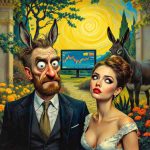The Wolf Mentality: A Dance of Power, Precision, and Purpose
The lone wolf isn’t a rebel for aesthetic reasons. They’re a rebel because obedience rarely pays
March 31, 2025
Introduction: The Call of the Wolf in Time and Markets
The “wolf mentality” isn’t a buzzword—it’s a primal code. It forged empires, moved markets, and carved its place into the psyche of those who refuse to follow. It’s the fusion of Machiavellian cunning and Platonic depth, where dominance meets discipline.
In markets and in life, the wolf rises by design, not accident. Patience without passivity, aggression without recklessness, purpose without noise.
So what does it really mean to think like a wolf? Not metaphorically—but in mindset, behavior, and execution. To answer that, we must trace its lineage—from myth to market, war rooms to trading desks.
The Historical Context: Wolves in the Shadows of Greatness
From the epic sagas of ancient Mesopotamia to the stoic wisdom of Roman philosophers, the wolf has stood as a symbol of power, cunning, and survival. In the Epic of Gilgamesh, the protagonist’s wolf-like ferocity is celebrated as a divine gift—a quality that allows him to conquer challenges and defy mortality itself.
Fast forward to Seneca, the Roman philosopher whose timeless insight laid the groundwork for the wolf mentality. “It is not because things are difficult that we do not dare; it is because we do not dare that things are difficult,” he declared. These words encapsulate the wolf’s essence: boldness born of necessity, daring born of survival.
Even in myth, wolves were never reckless—they thrived on calculated action, striking with precision and retreating when the odds turned unfavorable. This duality—fierce aggression tempered by strategic caution—is the DNA of the wolf mentality, past and present.
The Wolf Mentality in Modern Markets: Masters of the Hunt
In the world of trading and finance, the wolf mentality reigns supreme among the elite. It’s not about blind aggression but a finely tuned instinct for opportunity. Wolves don’t chase every rabbit—they stalk the ones that matter.
The Archetype of the Wolf Trader
Few figures embody this ethos better than Jesse Livermore, one of the most enigmatic traders in history. Livermore’s words are a clarion call to the wolves of Wall Street:
“The game of speculation is the most uniformly fascinating game in the world. But it is not a game for the stupid, the mentally lazy, the person of inferior emotional balance, or the get-rich-quick adventurer. They will die poor.”
The market wolf mentality concerns emotional control, strategic patience, and a ruthless focus on calculated risks. It exploits inefficiencies without being consumed by the market’s chaos. A true wolf doesn’t fear volatility—it thrives in it, knowing that chaos is where opportunities are born.
The Pack Versus the Lone Wolf
Wolves dominate because they’re adaptable. They strike solo when stealth is needed. They move as a pack when force must be multiplied.
In markets, the lone wolf is a precision weapon—unencumbered by herd psychology, driven by instinct, data, and inner clarity. No noise. No permission. Just execution.
But the pack has its place. A tight unit of sharp minds, trading insights instead of opinions, can create exponential edge. Not groupthink—group clarity.
The real strength? Knowing when to roam solo—and when to run with killers.
Mob Psychology and the Lone Wolf
Lone wolves don’t just resist the crowd—they see through it. Where the herd flocks to euphoria in bull runs and panic in crashes, the lone wolf stands still, watches, and acts with intent. Emotional swings don’t move them; they track them.
Aristotle once said, “The whole is greater than the sum of its parts.” In markets, that sum can turn irrational. Fear compounds, greed accelerates, and the result is distortion. The lone wolf doesn’t fight it—they exploit it.
Take the late-90s dot-com mania. While crowds cheered every tech IPO, investors like David Einhorn and Michael Burry didn’t buy the hype. They ran the numbers, saw the cracks, and either stayed out or went short. When the bubble burst, they didn’t flinch—they cashed in.
The Shadow Side: Beware the Reckless Wolf
However, not all who claim the wolf mentality truly embody it. The reckless wolf, blinded by greed or hubris, is a danger to itself. Success lies in understanding the thin line between boldness and recklessness—a line only the most disciplined wolves can walk.
Mass Psychology and the Wolf Pack: Harnessing the Power of the Collective
The wolf mentality is more than a lone predator’s drive—it extends into group dynamics, where the power of the pack reigns supreme. This is mirrored in herding behaviour in the financial markets, a phenomenon where investors abandon independent judgment in favour of following the crowd.
French polymath Gustave Le Bon captured this phenomenon with chilling precision:
“The masses have never thirsted after truth. They turn aside from evidence that is not to their taste, preferring to deify error if error seduces them.”
This insight speaks to the volatile nature of mass psychology, which can amplify trends, fuel bubbles, and accelerate crashes. Traders with a wolf mentality exploit these movements by positioning themselves strategically—feeding on the crowd’s fervour in moments of euphoria and their despair in moments of panic. The pack may be blind, but the wolf sees hunting opportunities amidst the chaos.
Technical Analysis with Teeth
For the wolf trader, technical analysis is not just a tool—it’s the razor-sharp edge of survival. As a wolf studies its prey before attacking, traders analyze patterns and trends to time their moves with surgical precision.
The lone wolf doesn’t just look at charts. They interrogate them. Patterns aren’t followed—they’re deconstructed. Why does this setup work here but not there? What changed beneath the surface?
Von Neumann nailed it: “Anyone who attempts to generate random numbers by deterministic means is, of course, living in a state of sin.” Charts can’t predict the future, but they can hint at inflection points. Lone wolves don’t worship signals—they use them as tools, not gospel.
They’ll layer technicals with macro insights, sentiment extremes, and—when needed—break out their indicators. The goal isn’t to conform. It’s to detect mispricing before others see it. Impulsive action is the death knell of the reckless predator; the calculated wolf thrives by blending instinct with intellect.
Cognitive Biases: The Wolf’s Shadow
But let’s be real. Going solo isn’t all edge and glory. As Shakespeare warned: “The fool doth think he is wise, but the wise man knows himself to be a fool.” Without feedback, conviction can morph into delusion.
Common pitfalls:
- Confirmation bias: Only hunting data that fits your thesis.
- Overconfidence: Thinking you’ve outsmarted the market—until it slaps back.
- Missed trends: Dismissing moves as ‘crowd-driven’ and sitting out real opportunities.
- Burnout: Holding contrarian positions while the market laughs in your face.
- Resource gaps: Lone wolves don’t have a team of PhDs or a Bloomberg terminal—yet.
That’s why smart lone wolves stay sharp. They build systems to challenge their thinking. They cross-check data. Some even find quiet allies—other independents who don’t drink the Kool-Aid.
The renowned psychologist Daniel Kahneman, a pioneer in behavioural finance, cautioned against these mental traps:
“The illusion that we understand the past fosters overconfidence in our ability to predict the future.”
Even the sharpest predator is not immune to the traps of its mind. The wolf mentality, often celebrated for its cunning, must also confront the pitfalls of cognitive biases.
The Ethical Edge: The Wolf’s Code
The wolf mentality often walks a fine line between brilliance and exploitation. While effective, its predatory nature can veer into the unethical. The distinction between strategic acumen and outright manipulation can become blurred, especially in the high-stakes arena of finance.
Roman emperor and Stoic philosopher Marcus Aurelius offers timeless wisdom that tempers the wolf’s ferocity with moral clarity:
“Do what is right, not what is easy.”
For the disciplined wolf, this maxim isn’t a constraint but a guiding principle—a way to channel raw power into a force that builds rather than destroys.
Legends of the Wolf Mentality: Case Studies in Action
George Soros: The Man Who Broke the Bank of England
In 1992, Soros exemplified the wolf mentality by shorting the British pound ruthlessly, earning over $1 billion in a single day. His actions, while controversial, demonstrated the calculated risk-taking and strategic vision that defines the wolf mentality.
Michael Burry: The Lone Wolf of the Subprime Crisis
Burry’s decision to bet against the housing market before the 2008 financial crisis showcased the independent thinking of a true wolf. He turned his foresight into extraordinary profits by rejecting the herd’s delusions and acting decisively.
The Wolf Mentality in the Digital Age: Adapting to a New Terrain
In the 21st century, the wolf mentality has evolved to navigate a landscape dominated by algorithms, AI, and big data. The rise of quantitative strategies requires a new breed of wolf that blends traditional cunning with technological prowess.
Ray Dalio, founder of Bridgewater Associates, captures the essence of this evolution:
“The biggest mistake investors make is to believe that what happened in the recent past is likely to persist.”
For the modern wolf, adaptation is the key to survival. The future predator must integrate the timeless principles of observation, strategy, and resilience with the cutting-edge tools of the digital age.
The wolf doesn’t fear change—it thrives on it.
Conclusion: Answering the Wolf’s Call
In the words of Carl Jung, the influential psychologist of the 20th century, “One does not become enlightened by imagining figures of light, but by making the darkness conscious.” This insight reminds us that true mastery in finance and life comes not from blindly embracing a single mentality but from understanding and integrating all aspects of ourselves and the world.
The wolf mentality isn’t for the timid—it’s a mindset forged in the crucible of risk, resilience, and relentless pursuit. The trader waits for the perfect setup, the entrepreneur seizes an opportunity amidst the chaos, and the leader inspires with strength and subtlety.
In markets, as in life, the wolf thrives not by chasing everything in sight but by hunting with precision and purpose. Understanding the wolf mentality unlocks a mindset that conquers challenges and rewrites destinies.
So, will you answer the call of the wolf? Or will you watch from the sidelines as the pack claims the spoils? The choice is yours.











